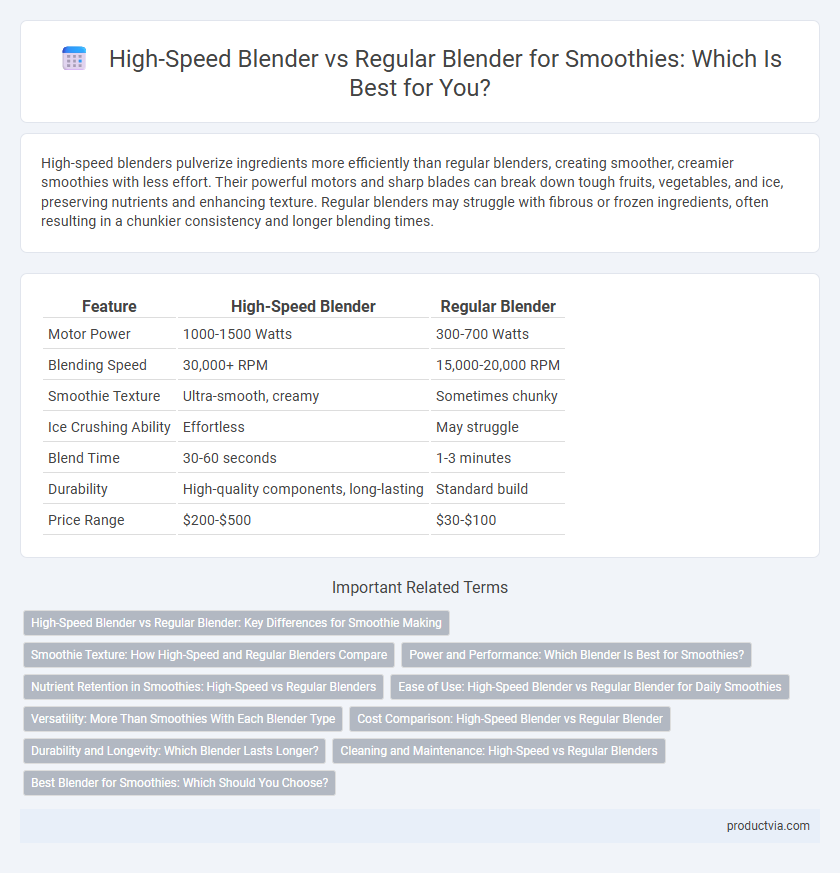High-speed blenders pulverize ingredients more efficiently than regular blenders, creating smoother, creamier smoothies with less effort. Their powerful motors and sharp blades can break down tough fruits, vegetables, and ice, preserving nutrients and enhancing texture. Regular blenders may struggle with fibrous or frozen ingredients, often resulting in a chunkier consistency and longer blending times.
Table of Comparison
| Feature | High-Speed Blender | Regular Blender |
|---|---|---|
| Motor Power | 1000-1500 Watts | 300-700 Watts |
| Blending Speed | 30,000+ RPM | 15,000-20,000 RPM |
| Smoothie Texture | Ultra-smooth, creamy | Sometimes chunky |
| Ice Crushing Ability | Effortless | May struggle |
| Blend Time | 30-60 seconds | 1-3 minutes |
| Durability | High-quality components, long-lasting | Standard build |
| Price Range | $200-$500 | $30-$100 |
High-Speed Blender vs Regular Blender: Key Differences for Smoothie Making
High-speed blenders utilize powerful motors ranging from 1000 to 1500 watts, enabling faster blade rotation speeds of up to 30,000 RPM for smoother, creamier smoothies compared to regular blenders with motors typically under 500 watts. Their advanced blade designs and variable speed settings allow efficient blending of tough ingredients like frozen fruits, ice, and greens, delivering consistent texture without compromising nutritional value. Regular blenders often struggle with fibrous or frozen components, resulting in uneven blending and a chunkier smoothie texture.
Smoothie Texture: How High-Speed and Regular Blenders Compare
High-speed blenders create smoother, creamier textures for smoothies by efficiently breaking down ice, frozen fruits, and fibrous ingredients into a consistent blend. Regular blenders often leave small chunks or graininess due to less powerful motors and lower blade speeds, affecting the overall mouthfeel. Choosing a high-speed blender enhances nutrient absorption and delivers a more enjoyable, velvety smoothie experience.
Power and Performance: Which Blender Is Best for Smoothies?
High-speed blenders, equipped with motors ranging from 1000 to 1500 watts, deliver superior power that effortlessly pulverizes frozen fruits, ice, and fibrous greens for smooth, creamy smoothies. Regular blenders typically offer motors around 300 to 600 watts, which may struggle with dense ingredients and produce chunkier textures. For smoothie enthusiasts seeking consistent performance and silky blends, high-speed blenders like Vitamix or Blendtec models provide unmatched blending efficiency and durability.
Nutrient Retention in Smoothies: High-Speed vs Regular Blenders
High-speed blenders reach rotor speeds of 20,000 to 30,000 RPM, efficiently breaking down cell walls to release more nutrients and improve smoothie texture compared to regular blenders operating at 10,000 to 15,000 RPM. The intense blending action of high-speed blenders minimizes oxidation and preserves vitamins like vitamin C and phytochemicals, enhancing overall nutrient retention. Regular blenders often leave larger pulp particles, reducing nutrient bioavailability and resulting in a less smooth, nutrient-dense smoothie.
Ease of Use: High-Speed Blender vs Regular Blender for Daily Smoothies
High-speed blenders offer superior ease of use for daily smoothies due to their powerful motors and pre-programmed settings, enabling smooth, consistent blending with minimal effort. Regular blenders often require manual speed adjustments and longer blending times, which can complicate the process for beginners or busy users. The efficient design of high-speed blenders reduces cleanup time and ensures a quicker preparation experience, making them ideal for daily smoothie routines.
Versatility: More Than Smoothies With Each Blender Type
High-speed blenders like the Vitamix and Blendtec offer superior versatility, effortlessly handling tasks beyond smoothies such as making nut butters, hot soups, and frozen desserts due to their powerful motors and advanced blade designs. Regular blenders typically perform well for basic smoothie preparation but often struggle with tougher ingredients, limiting their use for more complex culinary applications. Choosing a high-speed blender expands functionality in the kitchen, enabling a wide array of recipes that require consistent texture and blending precision.
Cost Comparison: High-Speed Blender vs Regular Blender
High-speed blenders typically cost between $200 and $600, offering powerful motors and advanced features suited for creating smooth, consistent smoothies, while regular blenders range from $30 to $100 with less motor power and fewer functionalities. The higher initial investment in a high-speed blender often results in better performance and durability, reducing the need for frequent replacements compared to regular blenders. For smoothie enthusiasts seeking efficiency and texture quality, the cost difference reflects enhanced blending capabilities and longevity.
Durability and Longevity: Which Blender Lasts Longer?
High-speed blenders typically feature more robust motors and durable components, resulting in extended lifespan compared to regular blenders. Their design accommodates frequent, intense use required for smoothies, reducing wear and tear on parts such as blades and bearings. Investing in a high-speed blender ensures long-term performance and reliability, making it preferable for regular smoothie preparation.
Cleaning and Maintenance: High-Speed vs Regular Blenders
High-speed blenders often feature self-cleaning modes and removable blades, making cleanup faster and more efficient compared to regular blenders which typically require manual disassembly and scrubbing. The powerful motor in high-speed blenders can pulverize residue during cleaning cycles, reducing stubborn buildup that is common in regular blender jars. Regular blenders usually have fewer components but may accumulate smoothie residue around the blade base, necessitating thorough hand washing to maintain hygiene.
Best Blender for Smoothies: Which Should You Choose?
High-speed blenders, such as the Vitamix or Blendtec, deliver superior performance with powerful motors exceeding 1,200 watts that effortlessly crush ice and blend fibrous fruits for ultra-smooth textures. Regular blenders typically operate at lower wattages around 300-600 watts, making them suitable for basic blending tasks but less effective for creamy smoothies with consistent texture. Choosing a high-speed blender ensures efficient nutrient extraction and smooth blends, ideal for daily smoothie enthusiasts seeking maximum texture and flavor.
High-speed blender vs regular blender for smoothies Infographic

 productvia.com
productvia.com